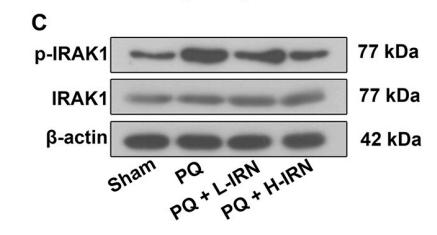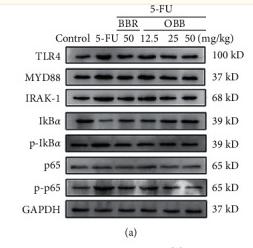| 产品: | IRAK1 抗体 |
| 货号: | AF4742 |
| 描述: | Rabbit polyclonal antibody to IRAK1 |
| 应用: | WB |
| 文献验证: | WB |
| 反应: | Human, Mouse, Rat |
| 预测: | Horse, Dog |
| 分子量: | 77kDa; 77kD(Calculated). |
| 蛋白号: | P51617 |
| RRID: | AB_2844740 |
产品描述
*The optimal dilutions should be determined by the end user.
*Tips:
WB: 适用于变性蛋白样本的免疫印迹检测. IHC: 适用于组织样本的石蜡(IHC-p)或冰冻(IHC-f)切片样本的免疫组化/荧光检测. IF/ICC: 适用于细胞样本的荧光检测. ELISA(peptide): 适用于抗原肽的ELISA检测.
引用格式: Affinity Biosciences Cat# AF4742, RRID:AB_2844740.
展开/折叠
AA48924; Il1rak; Interleukin 1 receptor associated kinase 1; Interleukin-1 receptor-associated kinase 1; IRAK; IRAK-1; Irak1; IRAK1-S; IRAK1_HUMAN; mPLK; OTTHUMP00000026014; OTTHUMP00000026015; OTTHUMP00000026020; OTTHUMP00000180621; Pelle; Pelle homolog; Pelle-like protein kinase; Plpk;
抗原和靶标
Isoform 1 and isoform 2 are ubiquitously expressed in all tissues examined, with isoform 1 being more strongly expressed than isoform 2.
- P51617 IRAK1_HUMAN:
- Protein BLAST With
- NCBI/
- ExPASy/
- Uniprot
MAGGPGPGEPAAPGAQHFLYEVPPWVMCRFYKVMDALEPADWCQFAALIVRDQTELRLCERSGQRTASVLWPWINRNARVADLVHILTHLQLLRARDIITAWHPPAPLPSPGTTAPRPSSIPAPAEAEAWSPRKLPSSASTFLSPAFPGSQTHSGPELGLVPSPASLWPPPPSPAPSSTKPGPESSVSLLQGARPFPFCWPLCEISRGTHNFSEELKIGEGGFGCVYRAVMRNTVYAVKRLKENADLEWTAVKQSFLTEVEQLSRFRHPNIVDFAGYCAQNGFYCLVYGFLPNGSLEDRLHCQTQACPPLSWPQRLDILLGTARAIQFLHQDSPSLIHGDIKSSNVLLDERLTPKLGDFGLARFSRFAGSSPSQSSMVARTQTVRGTLAYLPEEYIKTGRLAVDTDTFSFGVVVLETLAGQRAVKTHGARTKYLKDLVEEEAEEAGVALRSTQSTLQAGLAADAWAAPIAMQIYKKHLDPRPGPCPPELGLGLGQLACCCLHRRAKRRPPMTQVYERLEKLQAVVAGVPGHSEAASCIPPSPQENSYVSSTGRAHSGAAPWQPLAAPSGASAQAAEQLQRGPNQPVESDESLGGLSAALRSWHLTPSCPLDPAPLREAGCPQGDTAGESSWGSGPGSRPTAVEGLALGSSASSSSEPPQIIINPARQKMVQKLALYEDGALDSLQLLSSSSLPGLGLEQDRQGPEESDEFQS
种属预测
score>80的预测可信度较高,可尝试用于WB检测。*预测模型主要基于免疫原序列比对,结果仅作参考,不作为质保凭据。
High(score>80) Medium(80>score>50) Low(score<50) No confidence
研究背景
Serine/threonine-protein kinase that plays a critical role in initiating innate immune response against foreign pathogens. Involved in Toll-like receptor (TLR) and IL-1R signaling pathways. Is rapidly recruited by MYD88 to the receptor-signaling complex upon TLR activation. Association with MYD88 leads to IRAK1 phosphorylation by IRAK4 and subsequent autophosphorylation and kinase activation. Phosphorylates E3 ubiquitin ligases Pellino proteins (PELI1, PELI2 and PELI3) to promote pellino-mediated polyubiquitination of IRAK1. Then, the ubiquitin-binding domain of IKBKG/NEMO binds to polyubiquitinated IRAK1 bringing together the IRAK1-MAP3K7/TAK1-TRAF6 complex and the NEMO-IKKA-IKKB complex. In turn, MAP3K7/TAK1 activates IKKs (CHUK/IKKA and IKBKB/IKKB) leading to NF-kappa-B nuclear translocation and activation. Alternatively, phosphorylates TIRAP to promote its ubiquitination and subsequent degradation. Phosphorylates the interferon regulatory factor 7 (IRF7) to induce its activation and translocation to the nucleus, resulting in transcriptional activation of type I IFN genes, which drive the cell in an antiviral state. When sumoylated, translocates to the nucleus and phosphorylates STAT3.
Following recruitment on the activated receptor complex, phosphorylated on Thr-209, probably by IRAK4, resulting in a conformational change of the kinase domain, allowing further phosphorylations to take place. Thr-387 phosphorylation in the activation loop is required to achieve full enzymatic activity.
Polyubiquitinated by TRAF6 after cell stimulation with IL-1-beta by PELI1, PELI2 and PELI3. Polyubiquitination occurs with polyubiquitin chains linked through 'Lys-63'. Ubiquitination promotes interaction with NEMO/IKBKG. Also sumoylated; leading to nuclear translocation.
Cytoplasm. Nucleus. Lipid droplet.
Note: Translocates to the nucleus when sumoylated. RSAD2/viperin recruits it to the lipid droplet (By similarity).
Isoform 1 and isoform 2 are ubiquitously expressed in all tissues examined, with isoform 1 being more strongly expressed than isoform 2.
Homodimer (By similarity). Forms a complex with TRAF6, PELI1, IRAK4 and MYD88. Direct binding of SMAD6 to PELI1 prevents complex formation and hence negatively regulates IL1R-TLR signaling and eventually NF-kappa-B-mediated gene expression. The TRAF6-PELI1-IRAK4-MYD88 complex recruits MAP3K7/TAK1, TAB1 and TAB2 to mediate NF-kappa-B activation. Interaction with MYD88 recruits IRAK1 to the stimulated receptor complex. Interacts with TOLLIP; this interaction occurs in the cytosol prior to receptor activation. Interacts with IL1RL1. Interacts with PELI1 and TRAF6. Interacts (when polyubiquitinated) with IKBKG/NEMO. Interacts with RSAD2/viperin (By similarity). Interacts with IRAK1BP1 (By similarity). Interacts with PELI2 (By similarity). Interacts with ZC3H12A; this interaction increases the interaction between ZC3H12A and IKBKB/IKKB (By similarity). Interacts with IRAK4. Interacts with PELI3. Interacts with INAVA; the interaction takes place upon PRR stimulation. Interacts (via C-terminus) with NFATC4 (via N-terminus).
(Microbial infection) Interacts with mumps virus protein SH; this interaction inhibits downstream NF-kappa-B pathway activation.
The ProST region is composed of many proline and serine residues (more than 20 of each) and some threonines. This region is the site of IRAK-1 hyperphosphorylation.
Belongs to the protein kinase superfamily. TKL Ser/Thr protein kinase family. Pelle subfamily.
研究领域
· Environmental Information Processing > Signal transduction > MAPK signaling pathway. (View pathway)
· Environmental Information Processing > Signal transduction > NF-kappa B signaling pathway. (View pathway)
· Human Diseases > Infectious diseases: Bacterial > Pertussis.
· Human Diseases > Infectious diseases: Parasitic > Leishmaniasis.
· Human Diseases > Infectious diseases: Parasitic > Chagas disease (American trypanosomiasis).
· Human Diseases > Infectious diseases: Parasitic > Toxoplasmosis.
· Human Diseases > Infectious diseases: Bacterial > Tuberculosis.
· Human Diseases > Infectious diseases: Viral > Measles.
· Human Diseases > Infectious diseases: Viral > Epstein-Barr virus infection.
· Organismal Systems > Immune system > Toll-like receptor signaling pathway. (View pathway)
· Organismal Systems > Nervous system > Neurotrophin signaling pathway. (View pathway)
文献引用
Application: WB Species: Rat Sample: kidney tissues
Application: WB Species: Mice Sample:
限制条款
产品的规格、报价、验证数据请以官网为准,官网链接:www.affbiotech.com | www.affbiotech.cn(简体中文)| www.affbiotech.jp(日本語)产品的数据信息为Affinity所有,未经授权不得收集Affinity官网数据或资料用于商业用途,对抄袭产品数据的行为我们将保留诉诸法律的权利。
产品相关数据会因产品批次、产品检测情况随时调整,如您已订购该产品,请以订购时随货说明书为准,否则请以官网内容为准,官网内容有改动时恕不另行通知。
Affinity保证所销售产品均经过严格质量检测。如您购买的商品在规定时间内出现问题需要售后时,请您在Affinity官方渠道提交售后申请。产品仅供科学研究使用。不用于诊断和治疗。
产品未经授权不得转售。
Affinity Biosciences将不会对在使用我们的产品时可能发生的专利侵权或其他侵权行为负责。Affinity Biosciences, Affinity Biosciences标志和所有其他商标所有权归Affinity Biosciences LTD.



